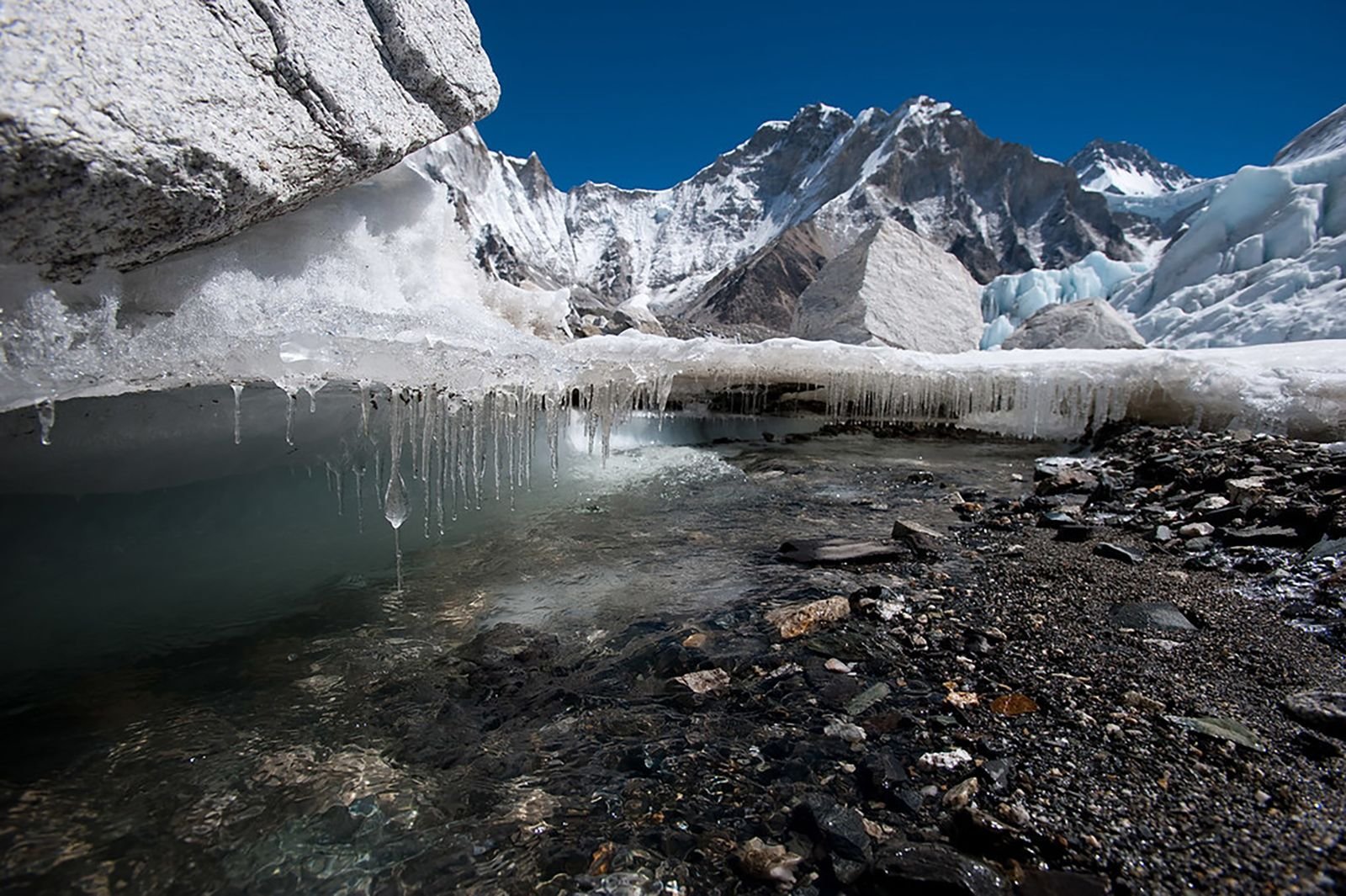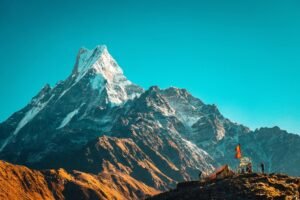The Himalayas, often referred to as the “Third Pole,” boast one of the most extensive and diverse glacial regions outside the polar areas. These glaciers are a crucial source of fresh water for millions of people in Asia, feeding major river systems such as the Ganges, Indus, Brahmaputra, and Yangtze. However, climate change poses a significant threat to these glaciers, which are retreating at an alarming rate. This article delves into the multifaceted impact of climate change on the Himalayan glaciers, examining the scientific evidence, the socio-economic repercussions, and potential mitigation strategies.
The Significance of Himalayan Glaciers
Himalayan glaciers play a pivotal role in regional hydrology and ecology. They act as natural reservoirs, storing water in the form of ice during the winter and releasing it as meltwater during the summer. This process ensures a continuous supply of water to rivers, which is essential for agriculture, drinking water, and hydroelectric power in downstream regions.
Ecological and Hydrological Importance
1. Water Supply: The meltwater from Himalayan glaciers sustains rivers that are lifelines for millions of people. For instance, the Ganges River, which is crucial for northern India, derives a significant portion of its flow from glacial meltwater.
2. Biodiversity**: The unique climatic conditions in the Himalayan region support diverse ecosystems. Glacial meltwater feeds into numerous lakes and wetlands, providing habitats for various plant and animal species.
3. Climate Regulation**: Glaciers reflect a significant amount of solar radiation, helping to regulate the Earth’s temperature. Their melting contributes to rising sea levels, affecting global climate patterns.
Observed Impacts of Climate Change on Himalayan Glaciers
Scientific studies have provided compelling evidence of the rapid retreat of Himalayan glaciers over the past century. Various factors contribute to this phenomenon, including rising temperatures, changes in precipitation patterns, and increased frequency of extreme weather events.
Glacial Retreat
Research indicates that the majority of Himalayan glaciers are shrinking. According to the International Centre for Integrated Mountain Development (ICIMOD), glaciers in the Himalayas have been retreating at an average rate of 10 to 60 meters per year. Notably, the Gangotri Glacier, one of the largest glaciers in the Indian Himalayas, has retreated by more than 1,500 meters in the last 70 years.
Temperature Rise
The Himalayas are experiencing a rate of warming that is significantly higher than the global average. This phenomenon, known as elevation-dependent warming, is partly due to the feedback mechanisms associated with reduced snow cover. As snow and ice melt, darker surfaces are exposed, which absorb more heat, further accelerating the melting process.
Changes in Precipitation
Climate change has also altered precipitation patterns in the Himalayas. There has been a noticeable decline in snowfall, which is crucial for replenishing glaciers. Additionally, an increase in rainfall, particularly during the monsoon season, contributes to faster melting and destabilization of glaciers.
Extreme Weather Events
The frequency and intensity of extreme weather events, such as heatwaves and heavy rainfall, have increased in the Himalayan region. These events can trigger glacial lake outburst floods (GLOFs), which pose severe risks to downstream communities. GLOFs occur when the natural dams of glacial lakes fail, releasing large volumes of water suddenly.
Socio-Economic Implications
The retreat of Himalayan glaciers has far-reaching socio-economic consequences, particularly for the millions of people who depend on the water resources these glaciers provide. The impact is evident in various sectors, including agriculture, water security, and energy production.
Agriculture
Agriculture in the Himalayan region and the adjacent plains is heavily reliant on glacial meltwater for irrigation. The retreat of glaciers threatens to reduce water availability during the crucial growing seasons. This reduction can lead to decreased agricultural productivity, food insecurity, and increased vulnerability to droughts.
The reduction in agricultural productivity not only affects local food supplies but also has broader economic implications. Many communities in the region depend on agriculture as their primary source of income. Reduced yields can lead to increased poverty and migration, as people seek alternative livelihoods.
Water Security
Glacial meltwater is a vital source of drinking water for many communities in South Asia. The reduction in glacial volume can lead to water shortages, particularly during the dry season. Urban areas, which are already facing water stress due to population growth and industrialization, will be particularly affected.
In rural areas, where access to alternative water sources is limited, the impact can be even more severe. Women and children, who are often responsible for collecting water, may have to travel longer distances, increasing their vulnerability to health issues and reducing time available for education and other activities.
Energy Production
Hydropower is a significant source of energy in many Himalayan countries, including Nepal and Bhutan. The reduction in glacial meltwater flow can decrease the capacity of hydroelectric power plants, leading to energy shortages and increased reliance on fossil fuels, which can further exacerbate climate change.
Energy shortages can also hinder economic development and affect the quality of life. In countries where hydropower is a major export, such as Bhutan, reduced energy production can impact national revenues and economic stability.
Environmental and Ecological Consequences
The environmental and ecological impacts of glacial retreat are profound. The changing landscape affects not only human populations but also the natural ecosystems that rely on the stability and continuity of glacial systems.
Glacial Lake Expansion
As glaciers retreat, they often leave behind depressions that fill with meltwater, forming glacial lakes. While these lakes can provide temporary reservoirs of water, they also pose significant risks. The natural dams holding these lakes can be unstable, and their failure can result in devastating floods downstream.
The formation of new glacial lakes and the expansion of existing ones also alter the hydrology of the region. These changes can disrupt traditional water management practices and affect the availability of water for various uses.
Ecosystem Disruption
The retreat of glaciers alters the hydrology of the region, affecting river flows and the ecosystems dependent on them. Wetlands and high-altitude lakes, which are crucial for biodiversity, are particularly vulnerable. Changes in water availability can lead to shifts in species composition and distribution, threatening the survival of many endemic species.
The loss of glaciers can also impact alpine ecosystems, which are adapted to cold and stable conditions. Species that depend on glacial meltwater, such as certain fish and invertebrates, may face extinction as their habitats disappear.
Permafrost Thaw
In addition to the glaciers, the Himalayan region contains significant areas of permafrost, which are also at risk due to rising temperatures. Thawing permafrost can release large amounts of greenhouse gases, such as methane, further accelerating global warming. Moreover, it can destabilize mountain slopes, increasing the risk of landslides and other geological hazards.
The thawing of permafrost can also affect infrastructure in the region. Roads, buildings, and pipelines built on permafrost may suffer from increased ground movement, leading to damage and increased maintenance costs.
Mitigation and Adaptation Strategies
Addressing the impacts of climate change on Himalayan glaciers requires a multi-faceted approach that includes both mitigation and adaptation strategies. These strategies must be informed by scientific research and tailored to the specific needs and conditions of the region.
Climate Change Mitigation
1. Reducing Greenhouse Gas Emissions**: The primary driver of glacial retreat is global warming caused by greenhouse gas emissions. Efforts to reduce emissions at national and international levels are crucial. This includes transitioning to renewable energy sources, enhancing energy efficiency, and implementing carbon pricing mechanisms.
2. International Cooperation**: The Himalayan region spans several countries, including India, China, Nepal, and Bhutan. Effective mitigation requires cooperation among these nations to implement policies that reduce emissions and promote sustainable development.
International cooperation is also essential for sharing knowledge and resources. Joint research initiatives, data sharing, and coordinated responses to climate change can enhance the effectiveness of mitigation efforts.
Adaptation Strategies
1. Water Management**: Developing efficient water management systems is essential to cope with reduced glacial meltwater. This includes building reservoirs, improving irrigation efficiency, and promoting water conservation practices.
2. Disaster Risk Reduction**: Strengthening early warning systems for glacial lake outburst floods and other climate-related hazards can help protect vulnerable communities. This involves monitoring glacial lakes, constructing protective infrastructure, and developing evacuation plans.
3. Sustainable Agriculture**: Promoting agricultural practices that are resilient to water scarcity, such as drought-resistant crops and efficient irrigation techniques, can help mitigate the impact on food security.
4. Research and Monitoring**: Continuous monitoring of glaciers and climate variables is essential for understanding the ongoing changes and predicting future scenarios. Investing in scientific research and data collection can inform policy decisions and adaptation strategies.
Adaptation strategies should also consider the social dimensions of climate change. Engaging local communities in planning and decision-making processes can ensure that adaptation measures are culturally appropriate and effectively address local needs.
Case Studies
The Gangotri Glacier
The Gangotri Glacier, one of the largest in the Indian Himalayas, has been extensively studied to understand the impact of climate change. Over the past few decades, the glacier has been retreating at an accelerated rate. The retreat of the Gangotri Glacier has significant implications for the Ganges River, which supports millions of people in northern India. Efforts to monitor the glacier and implement water management practices are crucial for ensuring water security in the region.
In response to the retreat of the Gangotri Glacier, the Indian government has initiated several measures. These include the development of artificial reservoirs to store meltwater and the implementation of water-saving techniques in agriculture. Additionally, efforts to raise awareness about water conservation among local communities are ongoing.
The Imja Tsho Lake
Imja Tsho, a glacial lake in Nepal, has grown rapidly due to the melting of the Im
ja Glacier. The expansion of this lake has raised concerns about the risk of a glacial lake outburst flood. In response, the Nepalese government and international organizations have undertaken efforts to lower the water level of the lake and strengthen the natural dam. This case highlights the importance of proactive measures to mitigate the risks associated with glacial lake expansion.
The Imja Tsho Lake project involved the construction of drainage channels to lower the water level and reduce the risk of an outburst. The project also included the installation of early warning systems and the training of local communities in disaster preparedness. These efforts have significantly reduced the risk to downstream villages and demonstrated the effectiveness of collaborative risk reduction strategies.
Long-Term Implications and Future Directions
The long-term implications of climate change on Himalayan glaciers extend beyond the immediate socio-economic and environmental impacts. The ongoing retreat of glaciers will continue to shape the region’s geography, hydrology, and climate for decades to come. Understanding these long-term implications is crucial for developing effective strategies to mitigate and adapt to climate change.
Glacier Dynamics and Future Projections
Predicting the future behavior of Himalayan glaciers requires sophisticated models that account for various factors, including temperature, precipitation, glacier geometry, and ice dynamics. Recent advances in remote sensing technology and climate modeling have improved our ability to project future changes in glacier mass and extent.
Studies suggest that even with aggressive mitigation efforts, many Himalayan glaciers will continue to shrink due to the delayed response of glaciers to climate change. This phenomenon, known as “glacial inertia,” means that the effects of past and present warming will continue to influence glacier behavior for years to come.
Hydrological Changes
The long-term changes in glacier mass will have profound effects on the hydrology of the region. As glaciers continue to shrink, the seasonal availability of water will become more variable. Initial increases in meltwater runoff may provide temporary relief, but this will be followed by a long-term decline in water availability as glaciers lose their capacity to store and release water.
Managing these changes requires a combination of structural and non-structural measures. Structural measures include the construction of dams and reservoirs to capture and store meltwater, while non-structural measures involve improving water use efficiency and promoting sustainable water management practices.
Biodiversity and Ecosystem Services
The long-term impacts on biodiversity and ecosystem services are complex and multifaceted. Changes in water availability and temperature will affect the distribution and behavior of species, potentially leading to shifts in ecosystems and the emergence of new ecological communities.
Conservation strategies must be adaptive and flexible to respond to these changes. Protecting key habitats, restoring degraded ecosystems, and enhancing connectivity between protected areas can help species adapt to changing conditions. Additionally, involving local communities in conservation efforts can ensure that these initiatives are sustainable and equitable.
Policy and Governance
Effective governance is critical for addressing the challenges posed by climate change in the Himalayan region. Policies must be informed by scientific research and grounded in the principles of sustainability, equity, and resilience.
National and Regional Policies
National governments in the Himalayan region have developed various policies to address climate change and its impacts on glaciers. These policies often include measures to reduce greenhouse gas emissions, promote renewable energy, and enhance disaster preparedness.
Regional cooperation is also essential for addressing transboundary issues related to water resources, biodiversity, and climate change. The establishment of regional platforms for dialogue and cooperation can facilitate the sharing of knowledge, resources, and best practices.
International Frameworks
International frameworks, such as the Paris Agreement, provide a critical context for national and regional efforts. By committing to ambitious targets for reducing greenhouse gas emissions and enhancing climate resilience, countries can demonstrate their commitment to addressing the global challenge of climate change.
International financial mechanisms, such as the Green Climate Fund, can provide the necessary resources for implementing climate adaptation and mitigation projects in the Himalayan region. Additionally, international organizations and research institutions can play a crucial role in supporting capacity-building and knowledge transfer.
Eeding :
The impact of climate change on Himalayan glaciers is a pressing issue with significant environmental, social, and economic implications. The rapid retreat of these glaciers threatens water security, agriculture, and energy production for millions of people in South Asia. Moreover, the environmental consequences, such as glacial lake expansion and ecosystem disruption, pose additional challenges.
Addressing these impacts requires a comprehensive approach that includes both mitigation and adaptation strategies. Reducing greenhouse gas emissions, enhancing international cooperation, and investing in sustainable practices are essential for mitigating the drivers of glacial retreat. At the same time, adaptation strategies, such as efficient water management and disaster risk reduction, are crucial for building resilience in the affected regions.
Scientific research and monitoring play a vital role in understanding the ongoing changes and informing policy decisions. By integrating scientific knowledge with practical solutions, it is possible to address the challenges posed by climate change and ensure a sustainable future for the Himalayan region and its inhabitants.
The future of the Himalayan glaciers depends on our collective actions today. By committing to sustainable development, reducing our carbon footprint, and supporting vulnerable communities, we can mitigate the impacts of climate change and preserve the vital resources that these glaciers provide. The challenges are immense, but with concerted effort and cooperation, it is possible to create a resilient and sustainable future for the Himalayan region and beyond.





